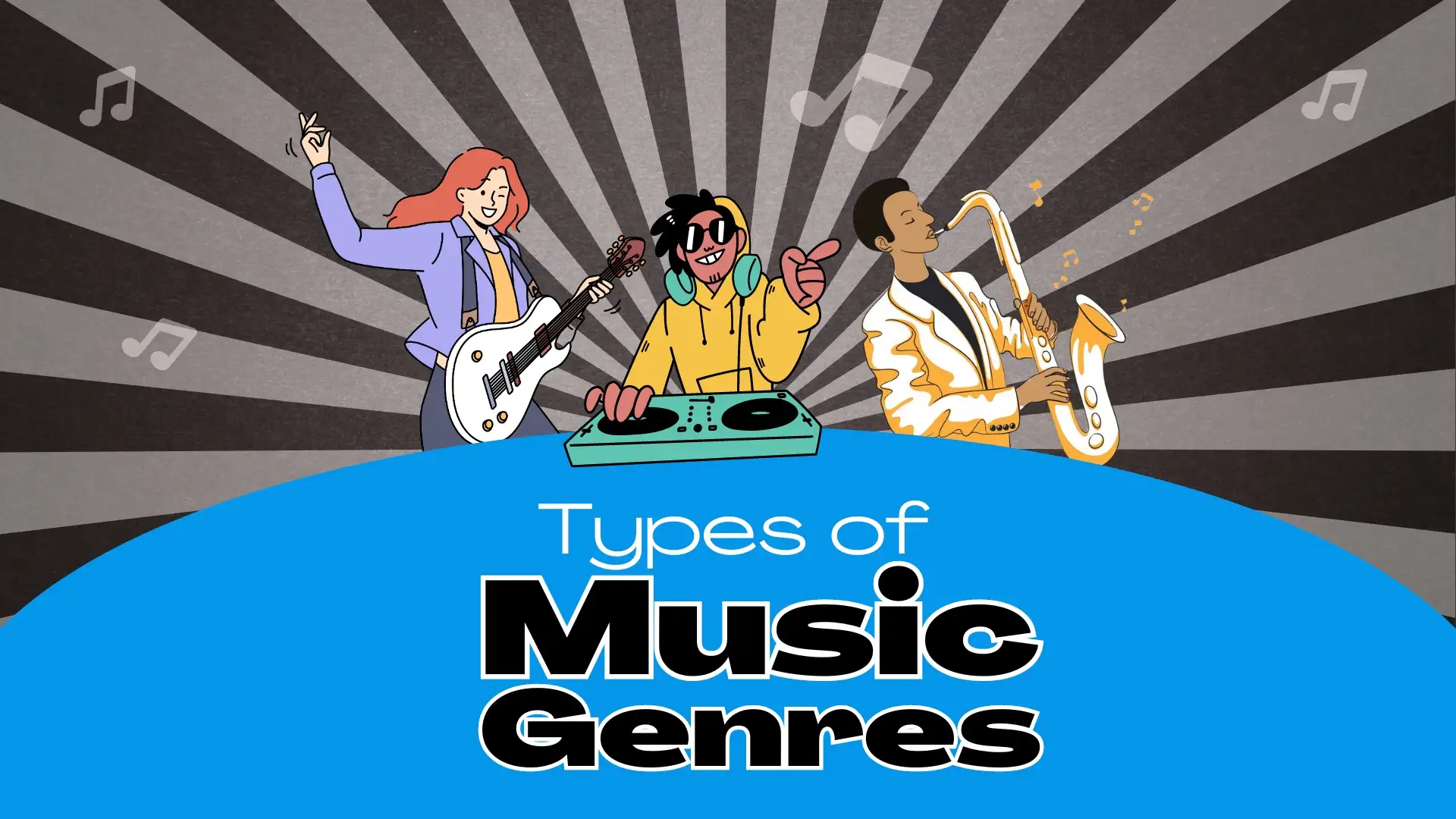Music encompasses a realm spanning genres that range from classical melodies to hip hop rhythms and country music. Each type of music genre has its essence whether it’s soulful ballads, love songs or purely instrumental compositions. Regardless of preferences, music has the ability to bring joy and facilitate emotional release. It acts as a force that fosters a sense of belonging among people. The inspiring power of music has played a role in cultures throughout history.

Music genres represent the manifestations of emotions, where every note contributes a vivid shade to the masterpiece of our shared soul.
In general songs can be classified into two categories; music and classical music. Popular music includes genres like rock, pop, country and hip hop—the tunes that top the charts. On the other hand classical music encompasses symphonies, operas and chamber music. Also there are folk music and traditional music.
However, within each music category lies an array of subgenres waiting to be explored. Whether one enjoys chart topping hits or delves into the compositions of works there is something out there for everyone to appreciate. In this article we will delve into these styles. Explore what makes each one uniquely special.
1. Pop Music
Pop type of music has been a part of our lives for more than a hundred years starting with jazz and swing in the 1900s. Over time it has. Transformed, transitioning from rock and roll in the 1950s to disco in the 1970s before becoming the genre we enjoy today. It’s one of dominant genre specially in american music.
The modern understanding of pop music as we know it originated in the mid 1950s in the United States and the United Kingdom. This includes the rise of different genres of music such as electronic music, which incorporates synthesized sounds. The term “music” encompasses genres that are often used interchangeably. During the 1950s and 1960s popular music included not rock and roll but other styles that catered to people’s preferences. It was common for “rock”. Pop” to be used interchangeably before the 1960s.
However after that time period pop music became associated with a appeal. Renowned musicians like Bing Crosby were given titles such as “King of Pop” or “King of Popular Music.”
Over time artists like Madonna and Michael Jackson have left their mark on pop music by infusing it with melodies and danceable beats. Pop music thrives on its ability to captivate listeners through hooks, memorable melodies and well-structured lyrics. It encompasses subgenres such as Ambient pop, Dancehall pop, Folk pop, jazz pop among others – all of which have garnered immense popularity, among audiences.
Sub Genres of Pop Music
Electro-Pop
This type of music blends pop music, with elements such as synthesizers and drum machines. Think of artists like Lady Gaga or Calvin Harris who incorporate these elements into their sound.
Synth-Pop
In the ’70s and ’80s this style heavily relied on synthesizers and catchy melodies. Artists like Depeche Mode and Pet Shop Boys gained popularity through their use of driven music.
Dance-Pop
Tailored for the club scene it’s a pop genre that emphasizes beats and rhythms. Madonna, Britney Spears and Rihanna are well known for their contribution to this genre.
R&B Pop
Combining the sounds of rhythm and blues with pop music it is characterized by vocals and memorable hooks. Beyoncé, Justin Timberlake and Mariah Carey have all ventured into this fusion successfully.
Pop Rock
This style brings together the catchiness of pop music with the guitar driven sound of rock. Maroon 5 Coldplay and OneRepublic often find themselves classified within this category due to their blend of pop sensibilities with rock influences.
Indie Pop
Originating from musicians or labels indie pop is recognized for its tunes and introspective lyrics. Artists such as Lana Del Rey, Lorde and Vampire Weekend are often associated with this genre of of popular music.
Tropical Pop
By infusing elements, like reggae and dancehall into mainstream pop tracks tropical pop creates a distinct fusion. Major Lazer, Justin Bieber and Ed Sheeran have all explored this style in their work.
Bubblegum Pop
This type of music genre is known for its tunes that’re upbeat and often appeal to younger audiences. Musicians such, as The Archies, Spice Girls and Carly Rae Jepsen are associated with this genre of popular music.
Power Pop
A fusion of pop melodies and the energy guitar driven sound of rock. It takes inspiration from bands, like Cheap Trick, Big Star and The Raspberries.
These various genres exemplify the diversity and evolving nature of pop music. Musicians continuously venture into styles and influences to craft sounds.
2. Blues Music
Blues music originated in 19th century America. Was initially inspired by the songs sung by workers and spiritual melodies. Over time it evolved into a genre known for its utilization of musical notes called “blue notes” and its ability to convey emotional stories through lyrics.
These songs often delve into the hardships of life emphasizing resilience and finding humor in circumstances. In the mid 20th century blues gained popularity with the introduction of guitars and louder instrumentation.
During this period renowned musicians, like Muddy Waters, B.B. King and Etta James became synonymous with blues music. It’s important to note that blues encompasses styles such as Delta blues, Chicago blues, Country blues, Jazz blues and Rhythm and Blues (R&B).
Ma Rainey, recognized as the “Mother of the Blues ” made contributions to blues singing from the 1800s to the early 1900s.
Furthermore, Zucchero deserves recognition as often referred to as the “Father of Blues” due, to his fame as one of Europe’s prominent blues musicians who achieved worldwide recognition.
Sub Genres of Blues Music
Blues music originating from communities has expanded into styles. Let’s explore some of them:
Delta Blues
This genre emerged from the Mississippi Delta region and is renowned for its sound. It features vocals and slide guitar with figures, like Robert Johnson and Son House.
Chicago Blues
With the migration of African Americans to Chicago in the mid 20th century this style gained prominence. It showcases guitars, harmonicas and full bands. Muddy Waters, Howlin’ Wolf and Buddy Guy played roles in shaping this genre.
Texas Blues
Originating from the Lone Star State, Texas Blues fuses blues with country and jazz elements. It often highlights guitar skills accompanied by a boogie woogie rhythm. Artists such as Stevie Ray Vaughan and T Bone Walker brought recognition to this style.
Piedmont Blues
Predominantly found in the Piedmont region this style stands out due to its fingerpicking guitar technique and ragtime influenced rhythms. Notable figures in this category include Blind Blake, Rev. Gary Davis and Brownie McGhee.
British Blues
British musicians diving into the American blues scene gave rise to Blues. It greatly influenced the 1960s British Invasion era while shaping bands, like The Rolling Stones, Eric Clapton and Led Zeppelin.
Jump Blues
Jump Blues, a genre that emerged in the 1940s is a blend of blues, swing and R&B. It is recognized for its lyrics, tempo and the enchanting presence of horn sections. The contributions of artists, like Louis Jordan and Big Joe Turner played a role in shaping this captivating style.
Memphis Blues
Originating from the city of Memphis this distinctive style draws inspiration from gospel, R&B and jazz. It often showcases vocals accompanied by soul stirring horns and a solid rhythm section. Legendary artists such, as B.B. King and Rufus Thomas have left marks on this genre.
These examples provide a glimpse into the tapestry of blues music. Each style possesses its qualities influenced by a variety of factors including culture, historical context and individual artistic expressions. All contributing to the rich heritage that defines blues music.
3. Jazz Music
Its originated in New Orleans during the 1800s and early 1900s blending elements of blues, ragtime and European music. It is renowned for its rhythms, syncopation and swinging ambiance.
In the 1920s it gained popularity thanks, to songs like “Crazy Blues” by Mamie Smith and “West End Blues” by Louis Armstrong. Over the years jazz achieved fame with contributions from artists such as Duke Ellington, Billie Holiday, Ella Fitzgerald and Miles Davis through hits like “Sophisticated Lady” and “Mood Indigo.” Jazz encompasses styles including Ballads, Bebop, Boogie woogie, Bossa nova, Cool jazz, Hard bop Latin jazz Mainstream jazz Modal jazz Progressive jazz Swing. Eubie Blake—a pianist, composer and songwriter—played a role, in shaping the era of jazz music.
Sub Genres of Jazz Music
Jazz music is similar, to a buffet offering an array of distinct flavors. Let’s explore some of the styles,
Bebop
This genre emerged in response to the dominance of band music during the 1940s. It is renowned for its paced melodies and intricate harmonies. Visionaries like Charlie Parker, Dizzy Gillespie and Thelonious Monk truly pushed the boundaries of this style.
Swing
In the 1930s and 1940s swing (also known as band jazz) took center stage. It is characterized by ensembles featuring brass instruments, woodwinds and rhythm sections. Think rhythms that’re perfect for dancing. Duke Ellington, Count Basie and Benny Goodman were figures in the swing era.
Cool jazz
This subgenre emerged in the 1940s to 1950s as a more relaxed response to high energy bebop. It revolves around sounds, improvisation and an overall laid back vibe. Miles Davis, Chet Baker and Dave Brubeck played roles in shaping this style.
Hard Bop
Coming into prominence during the 1950s bop blended bebop with elements of blues and gospel music. It features a rhythm section, captivating melodies and extended improvisations. Artists such as Art Blakey and the Jazz Messengers, Horace Silver and Cannonball Adderley made contributions, to this movement.
Jazz Fusion
During the 1960s and early 1970s jazz fusion emerged as a blend of jazz and rock elements. It infused R&B rhythms. Allowed for improvisation. Artists, like Miles Davis (during his fusion phase) Weather Report and Chick Coreas Return to Forever played roles in pioneering this genre.
Another fascinating variation is Latin jazz, which combines jazz improvisation with rhythms and instruments. It incorporates influences from Afro Cuban, Brazilian and other Latin styles. Renowned musicians such as Tito Puente, Dizzy Gillespie and Chucho Valdés have all made contributions to this captivating style.
These examples only scratch the surface of the range of flavors, within the world of jazz. Jazz continues to evolve by drawing inspiration from traditions illustrating the incredible creativity found among its musicians.
4. Rhythm and Blues Music
Rhythm and Blues also known as R&B is a music genre that originated in the 1940s within african american communities. It emerged from the fusion of jazz, gospel and blues music. Has since incorporated influences, from hip hop and soul. R&B songs often explore themes of love heartbreak and personal struggles.
Legendary musicians like Sam Cooke, Aretha Franklin, Marvin Gaye Etta James and Stevie Wonder have made contributions to the music industry with their captivating vocals. Today contemporary R&B artists such as Alicia Keys, Beyoncé, Rihanna and Chris Brown continue to carry the torch. R&B remains a genre cherished by both long time fans and new listeners alike. It’s truly remarkable to think about how these talented R&B musicians have shaped the world of music.
Throughout history,”rhythm and blues” has been interpreted in ways. In the 1950s it gained popularity within blues songs before its influence on rock and roll was acknowledged in the mid 1950s. The term “R&B” was then embraced to encompass a range of genres that evolved from a combination of blues, gospel music and soul.
The Rhythm and Blues genre includes an array of song types that provide experiences, for listeners. These genres include Gospel, Funk,Soul,R&B and Hip Hop
Sub Genres of Rhythm & Blues Music
Rhythm and blues music boasts a past giving rise to styles of R&B music. Lets explore a few of them,
Motown
This genre was brought to life by the Motown record label, in Detroit during the 1960s and 1970s. It beautifully blends soul, pop and R&B featuring harmonies and polished production. Artists such as Stevie Wonder, The Supremes and Marvin Gaye played roles in popularizing this sound.
Soul Music
Soul music emerged in the 1950s and 1960s by fusing elements of gospel, R&B and blues from african american communities. It often showcases lyrics accompanied by a rhythm. Legendary figures like Aretha Franklin, Otis Redding and Al Green are synonymous with soul music.
Funk
The funk movement gained popularity during the 1960s and 1970s. Known for its rhythms, groovy bass lines and vibrant horn sections; funk draws inspiration from R&B, jazz and soul while placing emphasis on improvisation. Iconic artists like James Brown, Parliament Funkadelic and Sly and the Family Stone have left a mark on this genre.
Contemporary R&B
Representing the evolved form of R&B is R&B which seamlessly blends elements of pop hip hop; along with influences is one of a early 20th centuries music genres. Esteemed artists such as Beyoncé,Rihanna and Bruno Mars have made contributions, to shaping this genre.
Neo-soul
A genre that emerged in the 1990s seamlessly blends elements of R&B, soul and hip hop. It harmoniously combines instrumentals, with meaningful lyrics. Erykah Badu, D’Angelo and Lauryn Hill stand out as figures within this genre.
Quiet Storm
A soothing variant of R&B that originated in the 1970s is characterized by its paced and comforting songs filled with love drenched lyrics. Renowned artists such as Smokey Robinson, Luther Vandross and Anita Baker are closely associated with this style.
Contemporary Gospel Music
Contemporary Gospel Music is a fusion of gospel music with elements of R&B, pop and soul. It often features empowering lyrics accompanied by performances. Kirk Franklin, Mary Mary and Tasha Cobbs Leonard are among the artists who have made contributions to this genre.
R&B music continually evolves by drawing inspiration, from genres while showcasing its creative expression.
5. Rock and Roll Music
Rock and roll type of music emerged during the 1920s drawing inspiration from blues, gospel and country music. However it truly gained momentum in the 1950s when artists, like Elvis Presley embraced a blend of rhythm and blues propelling the genre to popularity. Over time rock and roll branched out into subgenres including heavy metal and punk rock.
Notable figures in the world of rock and roll include Elvis Presley himself as iconic bands such as The Beatles, Led Zeppelin, Jimi Hendrix and Nirvana. This diverse genre encompasses an array of songs ranging from rock to variations, like glam rock, punk rock, synth pop, progressive rock, alternative rock indie rock ska rap rock funk rock math rock post rock.

Did You Know?
The term “punk rock” emerged in the 1970s as a way to describe a genre that was rebellious and anti-establishment. It’s said that the name came about when a journalist in a review of a band’s performance used the word “punk” to capture their unpolished sound.
6. Rock Music
Rock type of music emerged in the 1950s drawing inspiration from musicians such, as Elvis Presley and Chuck Berry. As time passed it diversified during the 1960s and 1970s giving rise to genres like metal and punk rock. By the 1980s notable artists like Michael Jackson and Queen were making contributions, to this music scene.
7. Country Music
Country music has a history rooted in the songs brought over by settlers and the musical traditions of African Americans, in the Southern regions. Following World War II a new style known as “honky gained popularity focusing on themes like heartbreak. The 1970s witnessed the emergence of “outlaw country,” which rebelled against mainstream production. Throughout its evolution this type of music has absorbed influences from rock and pop while still embracing its sounds such as bluegrass and Western swing.
Renowned figures in country music include Johnny Cash, Parton, Willie Nelson and Taylor Swift. Vernon Dalhart is often regarded as a trailblazer in this genre. Country music boasts an array of subgenres including Bluegrass, Bakersfield Sound, Early Country & Western Swing Country Pop, Alternative Country music, Country Folk, Nashville Sound and Country Rock. Other styles like New Traditionalists and Appalachian Folk have also made contributions, to this musical landscape. Furthermore Honky Tonk and Progressive Country music are parts of this tapestry. Lets not forget those cowboy themed songs that bring a unique flavor to the genre!
8. Soul Music
Soul types of music emerged during the 1950s blending elements of gospel and rhythm and blues to create charged and impactful songs. However it truly soared in popularity during the 1960s thanks, to the breakthrough hits of figures such as Aretha Franklin, Otis Redding and James Brown. In a response to the Civil Rights movement soul musicians used their music as a platform to voice their opposition against racism and inequality.
Although soul music faced some decline in the 1970s its influence endured through the contributions of names like Adele, Amy Winehouse and Bruno Mars. These artists added their touch to this genre. Ray Charles played a role in laying down the foundations of soul by merging blues, R&B and gospel in the 1950s. Often referred to as “The Godfather of Soul ” James Brown remains a figure, within this style.
Soul music encompasses subgenres including Detroit Motown, deep soul, Memphis Soul, New Orleans sound, Chicago soul, Philadelphia Soul; it even extends into Psychedelic and Blue eyed genres.
9. Dance Music
Dance music has been a part of our culture since the 1900s. In the era of the 1970s disco emerged as a phenomenon gifting us timeless hits such, as Gloria Gaynors empowering anthem “I Will Survive” and the Bee Gees infectious tune “Stayin’ Alive.”
As technology progressed clubs started witnessing the rise of new forms of electronic dance music. By the 1990s genres like house music, techno and trance gained popularity. Influential artists, like Daft Punk, The Chemical Brothers and Tiesto played roles during this era. Within this category numerous subgenres thrived including house, techno, drum & bass jungle hardcore, electronica, industrial beats, breakbeat rhythms, mesmerizing trance soundscape experiences; not forgetting UK garage and electro vibes.
10. Hip Hop Music
In the 1970s hip hop emerged in the Bronx combining street poetry, music and DJing. Over time it has grown into a genre encompassing rap, R&B and even pop music.
The hip hop culture is built upon four pillars; DJing, rapping (or MCing) breakdancing (or b boying) and graffiti. It has given rise, to sub genres like trap music, grime, gangster rap, rap rock (also known as nu metal) crunk, chillhop, bounce music, mumble rap, Latin hip hop and conscious hip hop.
Aside from its significance hip hop has also made an impact on the business world with numerous successful musicians. Its influence can be seen in fashion trends and memorable advertising jingles. Some notable artists within this genre include Afrika Bambaataa, Dr. Dre. And Drake. Hip hop encompasses a range of song types such, as trap music; grime; gangsta rap; rap rock; crunk; chillhop; bounce rap; Latin hip hop;. Conscious hip hop.
Discover the variety of voices in our blog post as we delve into the different kinds ranging from authoritative and convincing, to calming and motivating. Unveil the influence wielded by styles and gain insights into how they shape the dynamics of communication.
11. Indian Classical (Hindustani & Carnatic Styles)
In India classical music can be categorized into two styles; Hindustani originating from the regions and Carnatic originating from the southern parts. Both styles have their roots deeply embedded in Hindu traditions and texts but have also been influenced by Persian and Islamic elements. These captivating musical genres encompass an array of compositions such, as Bhajans ( songs) and Thumri (poetic love songs).
During the reign of the Vijayanagara Empire in Hampi there existed a Hindu composer and music expert named Purandara Dasa (1484-1564). In recognition of his contributions to the world of music he was bestowed with the title “Pithamaha,” meaning “grandfather” in Sanskrit.
Another prominent musician of that era was Tansen, who joined Emperor Akbars court when he was 60 years old. Many Hindustani schools of music trace their lineage back to him. Today Indian classical music continues to thrive being performed both in settings as well as blending harmoniously with Western influences.
Hindustani music encompasses captivating genres including Dhrupad, Khayal, Tarana, Thumri, Dadra and Gazals. On the other hand Carnatic music is characterized by its creativity. Includes styles such as Alpana Niraval Kalpnaswaram and Ragam Thana Pallavi.
12. Sufi Music
Sufi Music traces its origins back to Hindu practices and literature. Has been shaped by traditions over time. It’s a genre that includes styles like qawwali and ghazal often expressing themes of love, devotion and the pursuit of truth.
Renowned Sufi musicians such as the Sabri Brothers from Pakistan and Mahsa Vahdat from Iran have left their mark on this genre. Whether performed solo or in a group Sufi music remains a means of conveying messages. There are types of Sufi songs, including Qawwali, Qaul, Qalbana and Ghazal each with its unique characteristics.
In summary there are various types of music genres with their fascinating histories and influences. Alongside genres like hip hop and classical music Sufi music holds a place. Platforms like Musicmaster focus, on promoting education to help people understand the origins of different musical styles and explore new songs. So if you’re curious expand your horizons today by immersing yourself in sounds!
FAQs
What are the primary music genres?
The primary music genres consist of pop, rock, hip hop, electronic, jazz, classical and country music.
How many different music genres exist?
The number of music genres is not fixed since they are diverse and continually evolving. However there are recognized genres and subgenres.
How do we classify music genres?
We classify music genres based on shared characteristics, like rhythm, melody, harmony, instrumentation and cultural influences.
What sets apart a music genre from a subgenre?
A music genre serves as a category encompassing styles of music while a subgenre represents a more specific and distinctive subset, within a particular genre. Subgenres often have unique elements.
Can you provide examples of hybrid music genres?
Some examples of music genres include electro pop, country rap and jazz fusion.
Are there any “music genres”? Are they all blended together?
Most music genres exhibit elements of fusion and influence making it difficult to identify “genres as they typically incorporate stylistic elements.
What sets apart genre and style in the realm of music?
Genre categorizes music based on shared characteristics and cultural conventions whereas style encompasses the approach and artistic elements employed within a specific genre.
Related blog: List of Top Tamil Songs











































